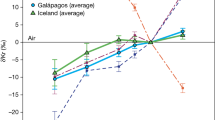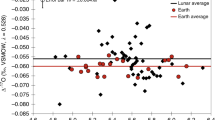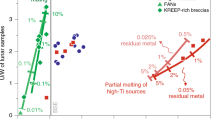Abstract
Differences in isotopic abundances between meteorites and rocks on Earth leave unclear the true composition of the gas out of which the Solar System formed1,2,3,4. The Sun should have preserved in its outer layers the original composition, and recent work has indicated that the solar wind is enriched in 16O, relative to Earth, Mars and bulk meteorites5. This suggests that self-shielding of CO due to photo-dissociation, which is a well understood process in molecular clouds, also led to evolution in the isotopic abundances in the early Solar System. Here we report measurements of oxygen isotopic abundances in lunar grains that were recently exposed to the solar wind. We find that 16O is underabundant, opposite to an earlier finding5 based on studies of ancient metal grains. Our result, however, is more difficult to understand within the context of current models, because there is no clear way to make 16O more abundant in Solar System rocks than in the Sun.
This is a preview of subscription content, access via your institution
Access options
Subscribe to this journal
Receive 51 print issues and online access
$199.00 per year
only $3.90 per issue
Buy this article
- Purchase on Springer Link
- Instant access to full article PDF
Prices may be subject to local taxes which are calculated during checkout


Similar content being viewed by others
References
Clayton, R. N. Oxygen isotopes in meteorites. Annu. Rev. Earth Planet. Sci. 21, 115–149 (1993)
Birck, J. L. An overview of isotopic anomalies in extraterrestrial materials and their nucleosynthetic heritage. Rev. Mineral. Geochem. 55, 25–64 (2004)
Wiens, R. C., Bochsler, P., Burnett, D. S. & Wimmer-Schweingruber, R. F. Solar and solar wind isotopic compositions. Earth Planet. Sci. Lett. 226, 549–565 (2004)
Wiens, R. C., Huss, G. R. & Burnett, D. S. The solar oxygen-isotopic composition: Predictions and implications for solar nebula processes. Meteorit. Planet. Sci. 34, 99–107 (1999)
Hashizume, K. & Chaussidon, M. A non-terrestrial 16O-rich isotopic composition for the protosolar nebula. Nature 434, 619–622 (2005)
Pillinger, C. T. Solar-wind exposure effects in lunar soil. Rep. Prog. Phys. 42, 897–968 (1979)
Hashizume, K., Chaussidon, M., Marty, B. & Terada, K. Protosolar carbon isotopic composition: Implications for the origin of meteoritic organics. Astrophys. J. 600, 480–484 (2004)
Hashizume, K., Marty, B. & Wieler, R. Analyses of nitrogen and argon in single lunar grains: towards a quantification of the asteroidal contribution to planetary surfaces. Earth Planet. Sci. Lett. 202, 201–216 (2002)
Ireland, T. R., Holden, P., Norman, M. D. & Clarke, J. Oxygen isotopes in lunar metal grains: A natural Genesis experiment. Lunar Planet. Sci. XXXV, abstr. 1448 (2004)
Wieler, R., Etique, P., Signer, P. & Poupeau, G. in Proc. 11th Lunar and Planetary Science Conference (ed. Merril, R. B.) 1369–1393 (Pergamon, New York, 1980)
Eugster, O., Grögler, N., Mendia, M. D., Eberhardt, P. & Geiss, J. Trapped solar wind noble gases and exposure age of Luna 16 lunar fines. Geochim. Cosmochim. Acta 37, 1991–2003 (1973)
Hashizume, K., Chaussidon, M., Marty, B. & Robert, F. Solar wind record on the Moon: Deciphering presolar from planetary nitrogen. Science 290, 1142–1145 (2000)
Ziegler, J. F., Biersack, J. P. & Littmark, U. The Stopping and Range of Ions in Solids (Pergamon, New York, 1985)
Martin, M., Mader, W. & Fromm, E. Oxidation of iron, aluminium and titanium films in the temperature range 50–200 °C. Thin Solid Films 250, 61–66 (1994)
Takada, J., Yamamoto, Y. & Adachi, M. Diffusion coefficient of oxygen in alpha-iron determined by internal oxidation technique. Z. Metallk. 77, 6–11 (1986)
Wieler, R., Kehm, K., Meshik, A. P. & Hohenberg, C. M. Secular changes in the xenon and krypton abundances in the solar wind recorded in single lunar grains. Nature 384, 46–49 (1996)
Clayton, R. N., Grossman, L. & Mayeda, T. K. A component of primitive nuclear composition in carbonaceous meteorites. Science 182, 485–488 (1973)
Nuth, J. A. I., Hallenbeck, S. L. & Rietmeijer, F. J. M. Interstellar and interplanetary grains: Recent developments and new opportunities for experimental chemistry. Earth Moon Planets 80, 73–112 (1998)
Thiemens, M. H. Mass-independent isotope effects in planetary atmospheres and the early solar system. Science 283, 341–345 (1999)
Thiemens, M. H. & Heidenriech, J. E. I. The mass-independent fractionation of oxygen—a novel isotope effect and its possible cosmochemical implications. Science 219, 1073–1075 (1983)
Clayton, R. N. Self-shielding in the solar nebula. Nature 415, 860–861 (2002)
Yurimoto, H. & Kuramoto, K. Molecular cloud origin for the oxygen isotope heterogeneity in the solar system. Science 305, 1763–1766 (2004)
Lyons, J. R. & Young, E. D. CO self-shielding as the origin of oxygen isotope anomalies in the early solar nebula. Nature 435, 317–320 (2005)
Young, E. D. in Workshop on Oxygen in the Early Solar System Abstr. 9010 (Gatlinberg, Tennessee, 2005); available at http://www.lpi.usra.edu/meetings/ess2005/ (2005).
CELIAS/MTOF experiment on the Solar Heliospheric Observatory (SOHO). http://umtof.umd.edu/pub/ (2005).
Young, E. D. & Russell, S. S. Oxygen reservoirs in the early solar nebula inferred from an Allende CAI. Science 282, 452–455 (1998)
Clayton, R. N. & Mayeda, T. K. The oxygen isotope record in Murchison and other carbonaceous chondrites. Earth Planet. Sci. Lett. 67, 151–161 (1984)
Acknowledgements
T. Senden carried out the atomic force microscopy of ion probe pits. NASA provided lunar soil 10084,85. This work was supported by the Australian Research Council. We thank M. Thiemens, K. McKeegan and U. Wiechert for discussions, and K. Hashizume, G. Huss and A. Davis for comments and suggestions.
Author information
Authors and Affiliations
Corresponding author
Ethics declarations
Competing interests
Reprints and permissions information is available at npg.nature.com/reprintsandpermissions. The authors declare no competing financial interests.
Supplementary information
Supplementary Notes
This file contains all Supplementary Information as follows: Supplementary Figure 1 and legend, Supplementary Figure 2 and legend, Supplementary Methods, and Supplementary Table 1. (DOC 223 kb)
Rights and permissions
About this article
Cite this article
Ireland, T., Holden, P., Norman, M. et al. Isotopic enhancements of 17O and 18O from solar wind particles in the lunar regolith. Nature 440, 776–778 (2006). https://doi.org/10.1038/nature04611
Received:
Accepted:
Issue Date:
DOI: https://doi.org/10.1038/nature04611
This article is cited by
-
The Exosphere as a Boundary: Origin and Evolution of Airless Bodies in the Inner Solar System and Beyond Including Planets with Silicate Atmospheres
Space Science Reviews (2022)
-
Future Missions Related to the Determination of the Elemental and Isotopic Composition of Earth, Moon and the Terrestrial Planets
Space Science Reviews (2020)
-
Oxygen Isotopes and Sampling of the Solar System
Space Science Reviews (2020)
-
Biogenic oxygen from Earth transported to the Moon by a wind of magnetospheric ions
Nature Astronomy (2017)
-
Extreme oxygen isotope anomaly with a solar origin detected in meteoritic organics
Nature Geoscience (2011)
Comments
By submitting a comment you agree to abide by our Terms and Community Guidelines. If you find something abusive or that does not comply with our terms or guidelines please flag it as inappropriate.



